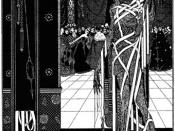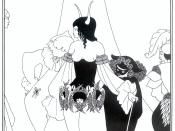American Romanticism
Symbolism in the Red Death
Edgar Allan Poe's short story entitled The Mask of the Red Death is an artistic example of vivid symbolism. Throughout the sinister tale Poe writes in a style that appeals to all five senses and captivates the reader's curiosity until the story's dour conclusion. Upon first glance, the story seems to be a complex tale of good versus evil. If the reader were to examine the story more deeply, they would then discover that the plot and symbolism intertwined throughout the narrative is no more than a simple metaphor for life and death.
A quick synopsis of the story tells the account of the affluent and overly confident Prince Prospero and his faulted attempt to escape death. Poe illustrates that Prospero is blinded by his riches and believes that he can escape death. A heavy dose of figurative language is used to create a struggle in which the mood goes from elation to somberness in just a mere three pages.
The characters of the story are well defined in that the reader can discover certain traits, good or bad, of the characters. For instance, Poe writes, "When his dominions were half depopulated, he summoned to his presence a thousand hale and light-hearted friends from among the knights and dames of his court" (44). This line identifies the Prince as a smug, insecure, and even foolish character, all the while foreshadowing a dark conclusion. These lines identify the Prince as the axis of the story by illustrating a few of his erroneous values and generate the story's dilemma.
The symbolism in the story adds to the chaos of the Prince's impending doom. "But first let me tell of the rooms in which it was held. There were seven...that there were few of the company...



Nice effort!
The writer did a fine job but the paper can be a little stretched that would make it better.
0 out of 1 people found this comment useful.